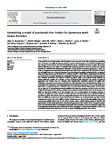Constraining a model of punctuated river incision for Quaternary strath terrace formation
| dc.contributor.author | Zondervan, JR | |
| dc.contributor.author | Stokes, M | |
| dc.contributor.author | Telfer, Matt | |
| dc.contributor.author | Boulton, Sarah | |
| dc.contributor.author | Mather, Anne | |
| dc.contributor.author | Buylaert, JP | |
| dc.contributor.author | Jain, M | |
| dc.contributor.author | Murray, AS | |
| dc.contributor.author | Belfoul, MA | |
| dc.date.accessioned | 2022-08-23T15:38:41Z | |
| dc.date.available | 2022-08-23T15:38:41Z | |
| dc.date.issued | 2022-10-01 | |
| dc.identifier.issn | 1872-695X | |
| dc.identifier.issn | 1872-695X | |
| dc.identifier.other | 108396 | |
| dc.identifier.uri | http://hdl.handle.net/10026.1/19556 | |
| dc.description.abstract |
In the small fraction of Earth's surface with the highest erosion rates such as the Alps and Himalayas quantifying rates of incision, rock uplift and inferring climatic controls on the landscape can be relatively straightforward once the ages of river terraces cut in bedrock (strath terraces) are constrained. However, in many mid to lower relief settings that are more typical of mountain belts worldwide, periods of net river incision and riverbed lowering are relatively short (punctuated), interrupted by long periods of sediment aggradation or stasis. We define a conceptual model of punctuated river incision and strath terrace formation for the calculation of incision and rock uplift rates, and recommend strategies for geochronological sampling and interpretation. An approach using OSL dating of terrace gravels allows us to constrain a detailed ~150 kyr history of punctuated river incision and strath terrace formation spanning two stratigraphic landform levels in the High Atlas Mountains (NW Africa). Extensive preservation and exposure of strath-top gravels, within a post-orogenic setting unaffected by eustatic influences, enables the derivation of rates of base-level fall, integrated over periods of strath-top aggradation and incision, that are consistent with independently constrained regional rock uplift rates. Combining a punctuated river incision model with our well-constrained terrace formation history allows us to demonstrate how assumptions concerning Quaternary river incision and aggradation can lead to the problematic Sadler Effect, an apparent dependence of incision rates on measured time interval. Subsequently, we demonstrate that an approach to reinterpreting previously published data using the punctuated incision model, even when combined with limited terrace age data, results in more consistent conclusions about rates of river incision, rock uplift and base-level lowering across the mountain belt. Our recommendations for sampling strategies to constrain rock uplift rates require samples to be taken just above the strath surface, and in addition towards the top of the deposit for river incision rates. In a setting with punctuated river incision and strath terrace formation, both rock uplift and incision rates require burial dates, as exclusive use of abandonment ages will not yield constraints on accurate rates of rock uplift or incision. Furthermore, we find that only with multiple along-stream locations and multiple burial dates in each terrace deposit, could a reliable climatic signal be extracted: this signal would not have shown up in terrace abandonment ages such as those derived from cosmogenic exposure dates. The demonstrated effects of assumptions about strath terrace formation, and the recommended approaches for sampling and interpretation, have implications for those attempting to constrain palaeoclimatic, tectonic, and geomorphic histories from strath terrace records in regions exhibiting punctuated river incision. | |
| dc.format.extent | 108396-108396 | |
| dc.language | en | |
| dc.language.iso | en | |
| dc.publisher | Elsevier | |
| dc.subject | Strath terraces | |
| dc.subject | Rates | |
| dc.subject | Sadler effect | |
| dc.subject | Chronology | |
| dc.subject | High Atlas | |
| dc.title | Constraining a model of punctuated river incision for Quaternary strath terrace formation | |
| dc.type | journal-article | |
| dc.type | Journal Article | |
| plymouth.author-url | https://www.webofscience.com/api/gateway?GWVersion=2&SrcApp=PARTNER_APP&SrcAuth=LinksAMR&KeyUT=WOS:000888221900004&DestLinkType=FullRecord&DestApp=ALL_WOS&UsrCustomerID=11bb513d99f797142bcfeffcc58ea008 | |
| plymouth.volume | 414 | |
| plymouth.publication-status | Published | |
| plymouth.journal | Geomorphology | |
| dc.identifier.doi | 10.1016/j.geomorph.2022.108396 | |
| plymouth.organisational-group | /Plymouth | |
| plymouth.organisational-group | /Plymouth/Faculty of Science and Engineering | |
| plymouth.organisational-group | /Plymouth/Faculty of Science and Engineering/School of Geography, Earth and Environmental Sciences | |
| plymouth.organisational-group | /Plymouth/REF 2021 Researchers by UoA | |
| plymouth.organisational-group | /Plymouth/REF 2021 Researchers by UoA/UoA07 Earth Systems and Environmental Sciences | |
| plymouth.organisational-group | /Plymouth/REF 2021 Researchers by UoA/UoA14 Geography and Environmental Studies | |
| plymouth.organisational-group | /Plymouth/Research Groups | |
| plymouth.organisational-group | /Plymouth/Research Groups/Marine Institute | |
| plymouth.organisational-group | /Plymouth/Users by role | |
| plymouth.organisational-group | /Plymouth/Users by role/Academics | |
| dcterms.dateAccepted | 2022-08-01 | |
| dc.rights.embargodate | 2022-8-24 | |
| dc.identifier.eissn | 1872-695X | |
| dc.rights.embargoperiod | Not known | |
| rioxxterms.versionofrecord | 10.1016/j.geomorph.2022.108396 | |
| rioxxterms.licenseref.uri | http://www.rioxx.net/licenses/all-rights-reserved | |
| rioxxterms.type | Journal Article/Review |


